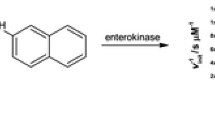Summary
On addition of insulin, invertase, and egg albumin, to the ferrous ferric redox couple (.002 M concentration of each cation in 1-N sulphuric acid), the transfer coefficient decreases, showing thereby that the substances behave almost like other surface active substances. When insulin or invertase are present in the solution, the transfer coefficient is .559, whereas on addition of egg albumin to the solution its value is .572. This shows that the former two are more effective detergents as compared to the latter.
The gelatin and inulin in the acid medium (used as supporting electrolyte) behave like dye indicators and in their presence, transfer coefficients are .591 and .630 respectively. It seems that inulin probably gets hydrolysed.
Zusammenfassung
Zufügung von Insulin, Intervase oder Eialbumin zum Ferro-Ferri-Redoxkomplex (0,002 Mol Konzentration von jedem Kation in 1 n Schwefelsäure) läßt den Transfer-Koeffizienten abnehmen, wobei sich zeigt, daß sich die Substanzen ähnlich wie oberflächenaktive Substanzen verhalten. Bei Gegenwart von Insulin oder Invertase in der Lösung ist der Transfer-Koeffizient 0,559, bei Anwesenheit von Eialbumin 0,572. Dies zeigt, daß die ersteren zwei wirksamer als das letztere Detergens ist.
Gelatine und Inulin in saurem Medium als Elektrolyt benehmen sich wie Farbindikatoren und lassen die Transfer-Koeffizienten zu 0,591 bzw. 0,630 werden. Es scheint, daß das Inulin hydrolysiert wird.
Similar content being viewed by others
References
Randles, J. E. B., Faraday Soc. Discussion1, 11 (1947).
Meites, L. andT. Meites, J. Amer. Chem. Soc.73, 177 (1951).
Gupta, S. L., Kolloid-Z.137, 86 (1954).
Doss, K. S. G. andH. P. Agarwal, J. Sci. Ind. Res.9 B, 280 (1950).
Agarwal, H. P., J. Sci. Soc. India2, 35 (1953).
Oldham, K. B., Trans. Faraday Soc.53, 80 (1957).
Barker, G. C., R. L. Faircloth andA. W. Gardner, Nature181, 247 (1958). Barker, G. C., Annal. chim. Acta18, 118 (1958).
Doss, K. S. G. andH. P. Agarwal, Proc. Indian Acad. Sci.34, 263 (1951). ibid.35, 45 (1952).
Delahay, New Instrumental Methods in Electrochemistry, pp. 385 (New York 1954).
Agarwal, H. P., Effect of simple molecules on transfer coefficient and kinetics of electrode processes (in course of publication).
Agarwal, H. P., Influence of dye-indicator on transfer coefficient of electrode processes (in course of publication).
Agarwal, H. P., Trans. Faraday Soc. (in course of publication).
Agarwal, H. P., Efficiency of detergents as determined by Faradaic rectification method (in course of publication).
Author information
Authors and Affiliations
Rights and permissions
About this article
Cite this article
Agarwal, H.P. Study of the effect of some macro-molecules on transfer coefficient of electrode processes. Kolloid-Z.u.Z.Polymere 186, 114–116 (1962). https://doi.org/10.1007/BF01499275
Received:
Issue Date:
DOI: https://doi.org/10.1007/BF01499275



